At Strophantine it is a cardiac glycoside, which is obtained from African trees, shrubs and creepers. The substance affects the sodium-potassium balance of the cells. This effect was used by medicine to increase the contraction force of the heart muscle.
What is strophantine?

The heart-working effect of strophantine became known to European doctors as early as 1859 as a participant in the Livingston expedition in West Africa. Locals used an extract from strophantus seeds as an arrow poison. A researcher accidentally ingested the seeds of a species of liana belonging to the Apocynaceae family and noticed in himself that it was effective on the heart.
In the course of time, the ingredient strophantine was found in various members of the dog venom family. There are trees and bushes, but also lianas that climb high and belong to the Strophantus species. Strophantus eminii, Strophantus gratus, Strophantus hispidus and Strophantus kombé are among the suppliers of the natural cardiac glycoside. The plants can contain different types of strophantine. In medicine, for example, a distinction is made between k-strophantin from the plant species Strophantus kombé, g-strophantin from Strophantus gratus, e-strophantin from Strophantus eminii and h-strophantus from Strophantus hispidus. G-strophantine is mainly used for medicinal purposes. The poisonous substance is fatal in high doses.
The Scottish doctor Thomas Richard Fraser isolated the k-strophantine in 1862. In 1888, the French Arnaud extracted g-strophantine from the African ouabaio tree. Numerous tinctures with different concentrations of the cardiac glycoside Strophantus were offered. The therapeutic effect was initially uncertain, even if the treatment was carried out in clinics.
Albert Fraenkel, a country doctor from Badenweiler, researched in addition to his practical work at the Pharmacological Institute at the University of Heidelberg and at the University Clinic in Strasbourg, substances that he expected to be useful as heart medication for his patients. He found that the intravenous administration of strophantine had a good therapeutic effect on heart disease. In order to achieve the desired effect and not to endanger the patient through the administration of strophantine, standardized solutions for intravenous administration were developed.
Strophantin was considered a standard drug for all types of heart failure until the 1970s. It is used for abnormal heartbeat, weakness or damage to the heart muscle after a heart attack, after flu or after an inflammation of the heart muscle in diphtheria, angina pectoris and high blood pressure.
Pharmacological effect
The pharmacological effect of strophantine is the influence of cardiac glycosides on the sodium-potassium pump. This is a protein-based transport system that occurs in cell membranes. This protein balances the flow of sodium ions out of the cell and potassium ions into the cell. The proper functioning of the sodium-potassium pump plays a vital role for the heart muscle cells and for the nerve cells. Heart failure can lead to imbalances in ion exchange. This has a weakening influence on the functionality of the heart cells.
The intravenous administration of strophantine slows down the transport of potassium ions out of the cell. At the same time, the calcium content in the cell is increased. These conditions increase the ability of the heart muscle cells to contract. The sodium-potassium pump is inhibited by a higher dose. In contrast, a small oral dose of strophantine stimulates ion exchange.
Medical application & use
Strophantine is the cardiac glycoside whose effect is the fastest of all available cardiac glycosides. Until 1992, strophantine was mentioned in official textbooks as the standard therapy for acute heart failure. Ampoules with the cardiac glycoside were available in every emergency doctor's suitcase. In the following years and up to the present day, strophantine was rarely used in the treatment of cardiac diseases in favor of other substances that have an effect on the heart, such as digoxin, a chemical compound found in thimble (digitalis purpurea). In the meantime only outdated studies are available that no longer meet today's scientific requirements, although the effectiveness of strophantine has been proven and documented in a long history of research.
The cardiac glycoside Strophantus is rarely used in university medicine. In alternative medicine, however, there are still homeopathic preparations that are used for the relief of chronic diseases of the heart. The drug picture recommends Strophantus, for example, for mitral valve insufficiency, which is very often associated with edema. Strophantus not only stimulates the heart muscles, it also supports the drainage of the tissue.
Risks & side effects
There are hardly any side effects to fear when a standardized solution from Strophantus is taken or administered intravenously. For many decades, strophantine was considered to be the heart drug that was effective and best tolerated. In some cases only a slight laxative effect was observed.
Even with a homeopathically potentized drug, no undesirable effects are to be expected if the strophantine was prescribed according to the patient's individual symptoms.
In contrast, high doses that are taken in an uncontrolled manner can be life-threatening.












.jpg)



.jpg)










.jpg)
